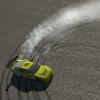Hello,
Well, I'm currently confused on how to achieve a stable simulation. My current simulation is good in terms of driveline, suspension and tires.
It works good with Joysticks and keyboard. But what I noticed is that when I use a ffb wheel, I notice that after a heavy braking the car wants to spin out. And I cant seem to recover. The car setup is a FR drivetrain, with a weight balance of 52/48
I use a raycast method for the whole wheel/suspension setup.
I use the calcualted suspension force as the load for the wheel.
I calculate the SlipAngle and SlipRatio the SAE950311 algorithm(with relaxations).
Tho I have to localize the tanSlipAngle and differentialRatio variables, otherwise the car will start springing around on bare ground, mostly caused by slip ratio.
The tiremodel I'm using is Pacejka89 + Beckman combined slip model.
I add the tire forces to 4 points of the car (mainly the wheel position + rollcenter offset (I dont know if this is correct, but it seems to make the simulation a little more realistic)
So lately I was looking into another method, that seemed to work better under braking.
Applying forces and torque directly do the body depending on the cg position + roll center positions (as jacking)
But this method seems to not entirely like my wheel load method (because of bumpstops and antirol bar calcs, I have to disable them to get it working) Also at low speed, it seems like this method wants to float sideways.
So I finally decided to come here and ask for some help. How are you guys initialising vechicles these days Do you apply forces to 4 points of the rigid body? Or do you apply the forces & torque directly do the body?
And how to calculate the wheel loads / weight transfer if usuing the cgOriented method?
Also about roll centers, where to use them exactly if I'm using the 4 point method?
Any help would be apriciated!
Thanks for your time








